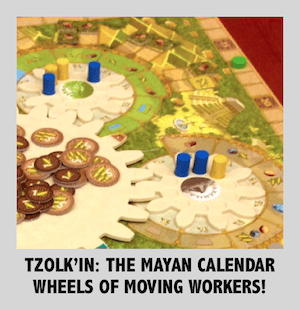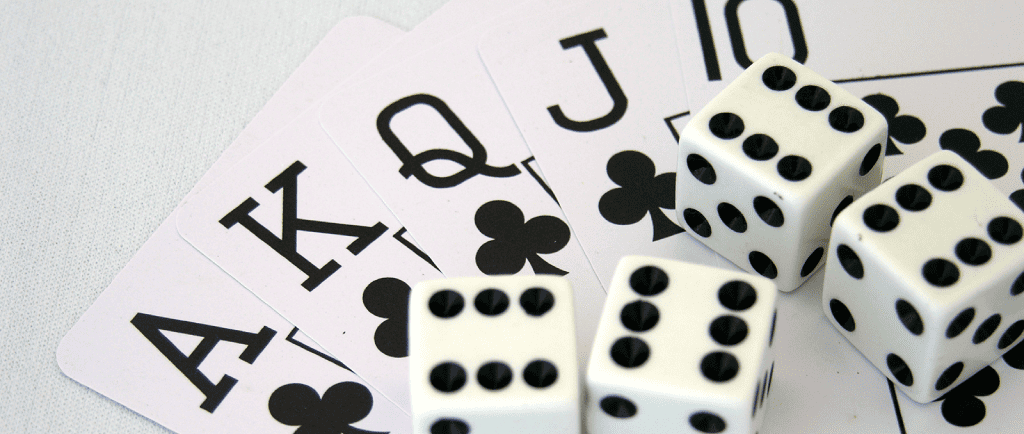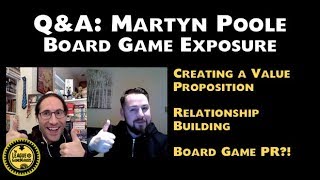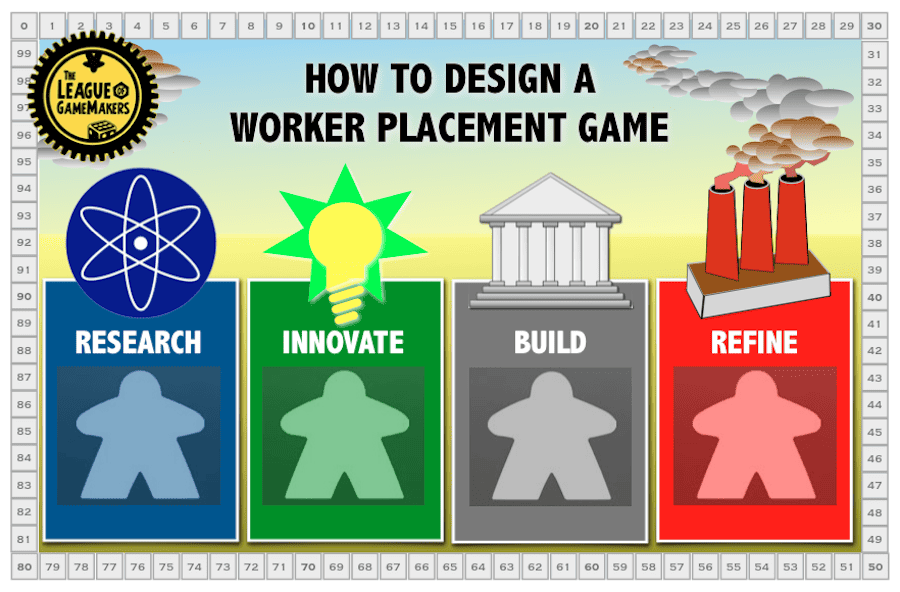
DO YOU WANT TO DESIGN A WORKER PLACEMENT GAME?
Are you working on a design, but want to make it better? Would you like to get tips from successful designers? If so, grab your meeples, and read on. I’ve broken the process down into 4 steps: Research, Innovate, Build, and Refine. Simply place your meeple in the appropriate space and then take the action indicated. In this installment, I cover the first two stages: Research and Innovate.
See also Part 2 of this series, in which I cover the Build step, and Part 3, in which I cover the Refine step. In Part 4, I discuss The Manhattan Project: Energy Empire.



1. START WITH RESEARCH
If you want to design worker placement games, you’ll need to do your research. This will include learning about principles of worker placement, playing worker placement games, and learning from the experiences of other designers.
KNOW WORKER PLACEMENT
Worker Placement is a game mechanic which involves placing your personal, limited supply of game pieces (workers) onto board spaces to gain resources or trigger effects, often to the exclusion of other players.
Some of the most heated debates on online forums involve definitions. What is a Euro game? What is a medium-heavy game? What constitutes “too much luck.” The definition of worker placement is no exception. For designers, here is what is most important to know:
- Be aware of which games are widely-accepted as worker placement games.
- Get to know the characteristics common to worker placement games.
- Worker placement can be the core mechanic in your game, triggering the vast majority of game effects, or it can play a lesser role, used to augment other mechanics like card drafting, tableau building, or area control.
- Don’t confuse genre with mechanic. There is absolutely no requirement that a worker placement game has to be a medium-heavy cube-pushing Euro-style game.
- You are under no obligation to design a game that fits the definition of worker placement. Design the game to be the way you want it to be, and let other people worry about defining it.

PLAY WORKER PLACEMENT GAMES
The most important step in your research is to play worker placement games. You need to be well-versed in both classic and newer innovative implementations of the mechanic. Ultimately, for your design to be successful, either as a kickstarter or to license to a publisher, you need a game that will sell, so you also need to learn some lessons from games that may not seem as innovative, but are still popular. And while this piece is focusing more on the mechanics of worker placement, theme and the feel of the game are, of course, very important.
WHICH GAMES SHOULD I SHOULD PLAY?
Below is a list of 10 worker placement games that was compiled based on a survey of game designers. You should play a breadth of worker placement games. There is no one, single worker placement game to end all others, but there are several that should be on every designer’s radar. Choose at least a few from the following list, but by no means confine your experiences to the games recommended here.
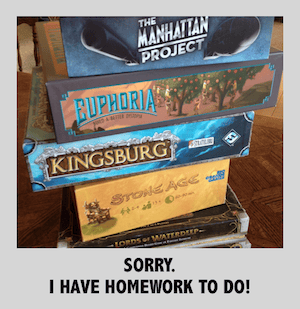
- AGRICOLA
- STONE AGE
- LORDS OF WATERDEEP
- CAYLUS
- TZOLK’IN
- VILLAGE
- PILLARS OF THE EARTH
- MANHATTAN PROJECT
- KINGSBURG
- EUPHORIA
Other games to explore: Keyflower, Alien Frontiers, Madeira, Dominant Species, Skagway, Viticulture, and Age of Empires III. Also take a look at the expansions for each of the above, where many innovations appear. See the Geeklist for more ideas and perspectives.

LEARN FROM THE EXPERTS
Fortunately, the boardgame design community is very forthcoming with information and advice. Many designers take time to share thoughts about their designs and their processes on blogs and forums like this one. I will include tips from several notable designers in the sections that follow.
“Play a wide variety of published worker-placement games. Play games where you place all of your workers at once or one per turn. Play games where you get the benefit right away or only at the end of the round. Play games where workers are meeples, dice, etc. Pay attention to what works and doesn’t work.” – Jamey Stegmaier
ADDITIONAL READING:
- Take This Job and Place It (A Guide to Worker Placement) by Jason Meyers
- Designer Diary: Kingsburg
- Designer Diary: The Manhattan Project
- Designer Diary: Lords of Waterdeep
- Uwe Rosenberg Interview on Agricola
- Jamey Stegmaier’s Blog



2. INNOVATION SPURS INNOVATION
It’s not enough to invent a new game. Tabletop gamers and publishers demand innovation. They are looking for a sweet spot of new and exciting themes and mechanics that also have a degree of familiarity. (See my previous post: “You Can’t Overuse a Good Theme.”)
Chances are, you’re a creative designer and you already have tons of ideas for new innovations in worker placement. You just need to figure out how to put all the pieces together. That said, it’s also entirely possible that you and many others are simultaneously working on the same innovations because of the natural progression of the field. (See Tom Jolly’s post which discusses independent invention: “Those Bastards Stole My Game!”)
Designers often describe how playing one game inspired them to contemplate a similar game with another theme, or a slightly different version of an existing mechanic. Once they started to tinker in this new direction, one change led to many others. While interviewing Brandon Tibbetts, designer of The Manhattan Project, he described how his dislike for variable turn order was one the driving factors in his development of the turn-based “place or remove” method of worker placement. This innovation led to others. In turn, other designers (including this author) have been inspired by various aspects of The Manhattan Project.
Brandon Tibbetts offers the following advice to designers: “Don’t feel stuck in the molds of what’s been done already with worker placement. There are a lot of nuances left to be explored. Different worker types. Instant activation/delayed activation (maybe combine both!) Varying degree of exclusivity when it comes to the spaces that are being occupied or activated. Maybe a player’s workers can directly interact somehow with another player’s workers. I don’t think I’ve seen that before. There’s a lot of talk about how worker placement is getting old, but I think there’s still a lot that can be explored with it.”

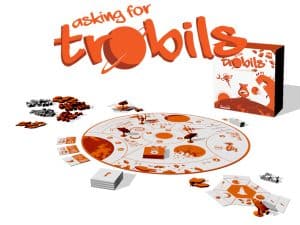
ASKING FOR TROBILS: A SPOTLIGHT ON INNOVATION
Christian Strain, a member of the League of Gamemakers, and co-designer Erin McDonald are in the process of putting the finishing touches on an innovative new worker placement game called “Asking for Trobils” which will hit Kickstarter in May of 2014. The game features a playful space theme, lots of orange, and rules that can be mastered in about 10 minutes.
Christian was kind enough to share some of his thoughts on the mechanical innovations in Asking for Trobils: “Asking for Trobils uses a lot of familiar mechanics as other worker-placement games, but one of the mechanics that set it apart from others is our wormhole location. Starting out, the players get only one ship. However, the science academy has discovered a wormhole that sends a ship forward in time while at the same time spitting it out the other end. This means that now there are two of you running around. A player can go through one more time to have three ships to use instead of just one. While you can bump other players from a spot, bumping into yourself will cause one of your ships to explode. The universe doesn’t like it when you meet yourself.”
PLAYTEST FOR OTHER DESIGNERS
When you have the opportunity to playtest new games by skilled designers, you get a chance to see where innovations are heading, while also getting to hone your own design skills. By volunteering for playtesting sessions at conventions, protospiel events, or by making personal connections with designers, you get the opportunity to make contributions to specific games, but also to the field as a whole. Every contribution you make helps you go back to your own work with more skills, and more awareness of what’s going on in your field.
Members of the League of Gamemakers have been playing and playtesting games designed by Jamey Stegmaier. (See our writeup of Tuscany, the expansion to Viticulture).
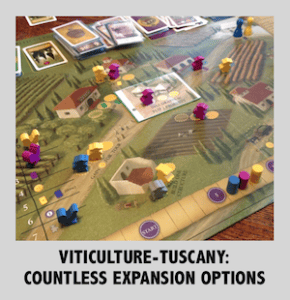
Stegmaier advises designers to draw inspiration from the theme: “If you’re going to design a worker-placement game, don’t think about the workers as meeples. Think about them as people. Do they want to do the thing you’ve asked them to do? How much time do they take to do that thing? Do they interact with each other? Are they getting smarter or happier? What does it take for them to get better at their jobs? Are they all the same? Think about workers as people, and it will open you to new aspects of worker placement that are perfect for your game’s theme and will bring something new to the genre.”
Some members of the League are also playtesting Treasure Mountain, a new worker placement game by Dan George, the designer of Road Kill Rally.
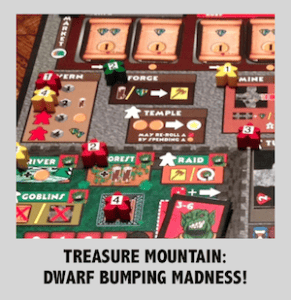
Treasure Mountain allows worker dwarves to displace(bump) other players’ dwarves with shorter beards, who then get to take a free turn. This mechanic makes more spaces available on each turn, and makes for a high level of player interaction. In the designers own words: “I feel a good worker placement design takes a compelling theme and wraps it around a mechanic with interesting choices that affect other players’ actions. Worker placement designs that block other players’ actions too much(stonewalling) can be frustrating, while ones with too little interaction are less interesting. The best games find the right balance between the two.”

STEAL THESE INNOVATIONS:
I’m a gamer and a game designer. I have nothing to lose from sharing ideas with you in the hopes that great games might be made from them that I will get to play. After all, none of us has the time or the resources to develop all of our ideas. So feel free to steal any of the ideas below, and feel free to share your own!
- Each turn you place one worker, then remove a different worker.
- Different worker types can only use certain types of board spaces.
- Different worker types use the same board spaces differently.
- Each worker has a “clearance level” that allows it use a certain range of board spaces.
- Combine worker placement with deck building.
- Workers are ticking time bombs that explode after a duration.
- Workers might betray you and change allegiance if treated badly.
- Some board spaces have effects when workers do NOT occupy them.
- Board spaces are never completely block-able, but require increasing resources to use depending on how many workers are already there.
- The benefit of a given space is entirely subject to the positions of other workers.
- Semi-cooperative traitor worker placement game.
- At the end of each round, workers do battle based on their locations
- Feel free to share your own innovation!
If you enjoyed this piece or other articles at the League of Gamemakers, consider voting for us on the “Best Boardgame Sites in the World” list.
If you enjoyed this piece, See Part 2 and Part 3!


